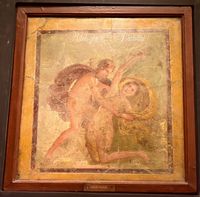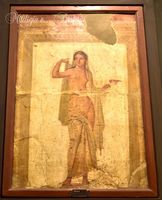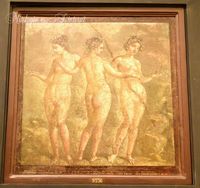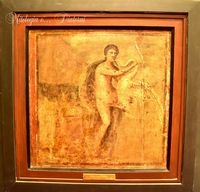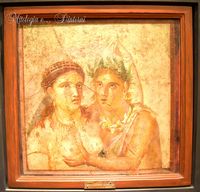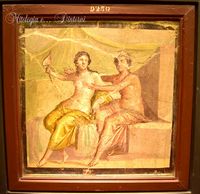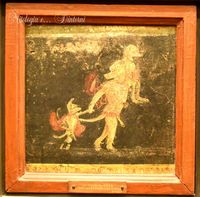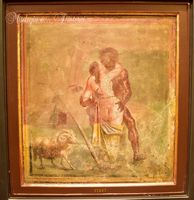la sessualità che protegge
Nel mondo romano il membro virile (un suo nome era fascinum da fas, favorevole, propizio) era ritenuto talismano di fecondità e augurio di prosperità; allo stesso modo esso teneva lontano il male. La combinazione di questo elemento con quell’altro potente rimedio apotropaico che era il rumore (spesso al collo dei bambini e degli ammali si mettevano dei campanelli, crepilacula e tintinnabula) spiega l’uso, frequentemente riscontrato a Pompei, di campanelli di bronzo sostenuti da falli o figure itifalliche. Sono ulteriormente combinati col motivo del dio del guadagno i sonagli modellati come Mercurio con la borsa delle monete in mano, dotato di ben cinque falli (inv. 27854) o a cavallo di un ariete itifallico (inv. 27855).
Il capolavoro di questa serie è una splendida figurina di gladiatore da Ercolano (inv. 27853) che combatte contro il proprio fallo la cui estremità si è trasformata in una belva che lo assale. La stessa fantasia “da metamorfosi” è nella figurina da Pompei di un fantino montato a cavallo di un grosso fallo alato (inv. 27844) sul cui capo egli pone una corona come fosse quello di un destriere vittorioso. La maggior parte di questi tintinnabula tuttavia (ad esempio inv. 27852, 27838, 27839, 27840) si limita semplicemente a ripetere il motivo del fallo-uccello-quadrupede, agganciandosi all’antico tema della tradizione greca identificante il sesso maschile come un uccello.
In quanto potente amuleto contrastante gli effetti dell’invidia e propiziatore di prosperità, il fallo si incontra in tutte le città antiche sulle mura, sui marciapiedi e sui basoli delle strade. A Pompei esso era spesso usato, scolpito su placche di tufo, nei cantonali delle case a proteggerle. Altrettanto tipica è la sua presenza sulle facciate delle botteghe e sui forni dei panifici. Famoso è a questo proposito il rilievo in travertino con fallo e scritta “hic habitat felicitas” (inv 27741), dal panificio nell’insula della casa di Pansa, che fu all’origine di un famoso studio sul ‘‘fascino” di Michele Arditi (1825). Altri grandi falli eretti erano realizzati in tre dimensioni, come vere e proprie sculture e sporgevano dalle pareti da cui emanavano la loro potenza benefica (inv. 113415). Oltre che all’osceno scolpito, i bottegai ricorrevano per la protezione dall’invidia anche alle pitture. È di eccellente fattura il quadretto con un Mercurio di stile popolaresco (inv. s.n.) che avanza truculento con la scarsella delle monete, il caduceo e un fallo enorme. Altrettanto famosa è un’insegna di bottega (inv. 27683) con un asino che sta penetrando un leone in cui ci sembra doversi vedere la trasposizione in immagine di un tema favolistico, “il mondo che va al contrario” o “la pazienza che vince la forza”.
Sex as a talisman
In the Roman world the male organ (known as the fascinum, deriving from fas meaning “favourable” or “propitiatory”) was regarded as a talisman of fecundity and prosperity which could also ward off evil influences. Another powerful charm was noise (babies and animals often had bells strung round their necks, known as crepitacula or tintinnabula), which explains the frequent occurrence in Pompeii of bronze bells supported by phalluses or ithyphallic figures. These bells were also associated with Mercury, the god of commerce, portrayed bearing a bag of coins in one hand and with no less than five phalluses (inv. 27854), or else riding an ithyphallic ram (inv. 27855).
The finest specimen of this series is the statuette of a gladiator from Herculaneum (inv. 27853) depicted in a fight with his own his own phallus, which turns on him like a wild beast. A similar “Metamorphosis” inspired the statuette found in Pompeii of a Jockey mounted on a large winged phallus (inv. 27844) in the act of crowning his victorious “steed”. However, most of these tintinnabula take the form of an imaginary phallus-bird-quadruped (e.g. inv. 27832, 27838, 27839, 27840), conserving the ancient Greek association of the male organ with a bird.
The phallic symbol was inscribed on walls, pavements and paving-stones in ancient Roman towns for its talismanic virtues in warding off envy and bringing prosperity. In Pompeii it is often found on tufa tablets hung up at the corners of houses to protect them. It was also displayed outside bakers’ shops and on their ovens: a famous example is the relief bearing a phallus and the motto “hic habitat felicitas” (inv. 27741) from the bakery in the insula of the House of Pansa, which gave rise to a celebrated study of the fascinum by Michele Arditi (1825): Other large erect phalluses were exhibited like statues, emanating their beneficent properties from walls and housefronts (inv. 113415). Shopkeepers protected themselves against ill-will and envy by putting up paintings as well as objects: in the small picture of Mercury in rustic style (no inv.), the god is seen advancing portentously with his money-bag in one hand a phallus instead of his serpent wand. Another famous shop sign is the ass mounting a lion (inv. 27683), which seems to be representation of a motto such as “the world upside down” or “patience triumphing over strength”.
The Neapolitan collection comprises a large number of personal amulets, more often than not in the form of pendants. These were made of materials believed to have special powers against diseases and the evil eye, such as coral, amber and so on. The shape of such talismans was also important, and as well as astrological symbols like the moon, or numbers, sexual iconography featured widely, as in the amulet pendants in the form of phalluses or male genitals. One further powerful talisman was the gesture of putting the thumb between the index and middle fingers, alluding to copulation. There are numerous pendants in the form of hands making this gesture, either alone or accompanied by other allusive images (such as fish), which served to increase the potency of the talisman.
Posiziona il mouse sulle immagini per avere maggiori informazioni
Foto di Giorgio Manusakis


